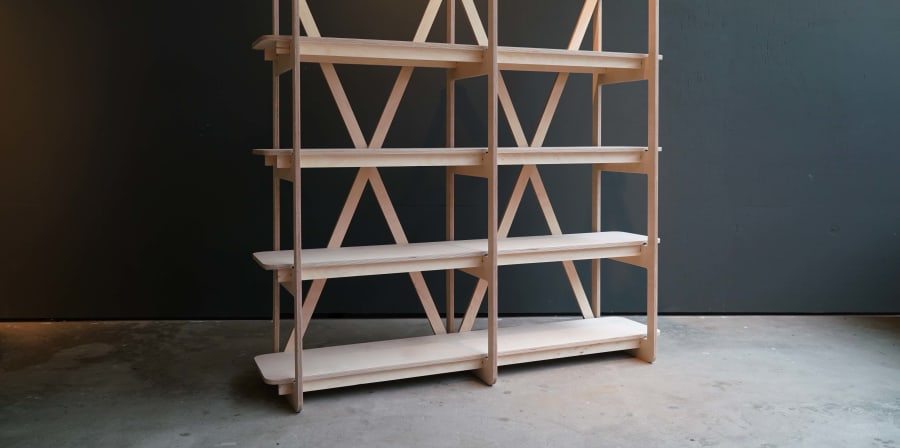
Camden Council, the Public Collaboration Lab (PCL) and MA Industrial Design students collaborated with local authority housing residents to alleviate overcrowding with affordable and adaptable furniture. PCL is focused on service, social and policy innovation and is an on-going action research and knowledge exchange initiative, originally stemming from an AHRC funded project conducted in 2015.
Central London is densely populated. This leads to a high demand for housing that drives up the price of accommodation. Increased costs combined with a shortage of social housing means that many families wishing to remain in their communities as they grow are living in overcrowded conditions.
In the borough of Camden, a high proportion of local authority residents live in over-crowded housing. Families outgrow their space but make-do: a living room becomes a bedroom at night, privacy is compromised and storage space is non-existent. There is less space to think, less space to be together and less space to be alone; what begins as a practical problem soon has social, psychological and health ramifications.
In 2015, Camden Council began a long-term project to tackle this issue guided by the Public Collaboration Lab (PCL), a research hub based at Central Saint Martins, and students on the MA Industrial Design course. At the core of PCL’s work is co-design, an approach that welcomes stakeholders and end-users into the design process. "You have to design ways for people to participate in a meaningful way... It’s about defining what you want to know from which group of people, and how you are going to find that out," explains PCL’s Principal Investigator Adam Thorpe.
The Council’s Overcrowded Housing Officer Rose La Touche identified 15 local families happy to take part in the project. By visiting each family in their own environment, La Touche and MA Industrial Design students began conversations about what issues they faced in their homes. These discussions could last for four hours, with the complexity of problems becoming only too apparent, encompassing education, health and housing among others. Though initial ideas had been object-based it soon became clear that a communication aid was also required – a way for both the residents and the Council representative to identify problems and initiate routes to tackle them.
The MA Industrial Design students divided into two groups. The first created an activity booklet, a tool to structure conversations, to identify problems and seek to solve them. Camden Council printed 3,000 copies and put them to use immediately. The second group took on the furniture angle. From the conversations with residents, they identified and committed to the alleviation of certain challenges, be it a lack of storage or little floor space or growing children and no privacy.
For the students, these projects took place during a ten-week period built into the curriculum, but real life does not stop when term does. The Overcrowded Housing Project was therefore passed on to the following year’s cohort of students. With the initial issues already identified, the new students ran workshops with different residents to gather additional insights into their needs.

"It was not like any other brief," says Elora Pierre, part of the second year of students, "we were working with people, real people. As design students we are often in contact with companies or professionals in our field, but this was the first time we worked with real people and we were all surprised by the relationships we were able to create. The connections were always natural and insightful, which was unexpected."
From their research, the students established that residents often felt their current ways of living reinforced a temporality of existence. Could a system be devised to deliver entirely bespoke, adaptable, yet affordable, furniture? It was clear that the furniture needed to be easy to assemble and so the students designed pieces that could be CNC-cut and slotted together without the use of tools. In meeting the challenges of tight spaces and bespoke sizes, digital technology continued to be the answer. When space is precious, a table ten centimetres too large has a big impact, so the students produced a digital programme that allows users to define their exact required dimensions.
The Camden participants received their new pieces of furniture, manufactured in the workshops at Central Saint Martins, but the Overcrowded Housing Project continues into its third phase: opening the service to the public. The specially-designed digital platform empowering users to create bespoke furniture will be connected to a local fabrication-lab (fab-lab) so the components can be cut quickly and nearby. PCL and Camden Council are currently in discussions with the King’s Cross Construction Skills Centre to realise this final phase. The impact of such socially-engaged projects often extends beyond the original defined aims. Pierre found such fertile ground here that her graduating work continues to look at connecting local communities with maker spaces.
After several years and with the input of numerous students and participants, the project is reaching its most tantalising point and its future realisation is almost tangible. A future in which residents head to a local fab-lab to make a piece of bespoke furniture they’ve co-designed to respond to, and improve, their individual situation. ‘It’s something out there that is shared and everyone brings their expertise,’ reflects Thorpe, "so, let’s go and do the stuff that needs doing."